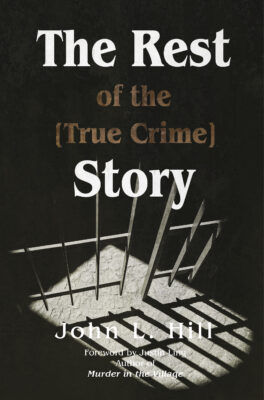When Law & Order Toronto: Criminal Intent premiered earlier this year, it was met with some good-natured bemusement on both sides of the border. Did there really need to be a Canadian version of the long-running American series? What would be so different about it, beyond colourful paper money and thinly veiled Rob Ford references?

The Rest of the [True Crime] Story
John L. Hill
AOS Publishing
$24.99
paper
366pp
9781990496387
In this way, John L. Hill’s non-fiction book The Rest of the [True Crime] Story serves as a primer on Canadian criminal law for many readers, with an emphasis on its many shortcomings, from arrest to prison transfers to parole. Hill has practiced and taught criminal and correctional law for forty years, and the book is divided into some of his standout cases – the bulk of them from the 1990s, which include stories of notorious criminals, wrongful convictions, and oft precedent-setting decisions. That it opens with the case of a serial rapist may put even the most open-minded readers on edge, yet it serves as a stark reminder that concepts Canadians may agree on theoretically – like the right to adequate legal representation – have human faces, and those faces aren’t always pretty.
Hill is a measured, straightforward writer who includes a lot of legal details and mentions of paperwork, perhaps an honest reflection of the bulk of a real attorney’s job (versus the network TV version). A salacious read this is not, and the average non-lawyer reader may gloss over a lot of the asides concerning statutes, dates, political parties, and the like, though one can easily imagine each of these chapters being delivered to eager, note-taking law school students.
Hill rarely inserts himself into the story with much dramatic flair, and when he does he often downplays what he must have been thinking or feeling. Which is, admittedly, likely why he’s made such an effective criminal lawyer; unflappable, at least in retrospect, even as he finds out his phone’s been bugged, or negotiates an escaped prisoner’s return (there are a wild number of jailbreaks in this book). Even as his own father tells him, “I hope you lose” after Hill reveals he’s defending child-killer Gary Leo Genereaux.
Rather than focusing on what makes a murderer, that chapter uses Genereaux’s case to expose a systemic lack of support for mentally ill prisoners. As usual, Hill doesn’t dwell on visceral details, but the facts alone are enough to shock: past experimental programs like Defence Disruptive Therapy, which involved nonconsensual hallucinogens; the cult-like Motivation, Attitude, Participation Program; and the Capsule Program, which had overseers chaining naked men together in a tiny, windowless cell, feeding them soup and milk through a straw in the wall.
Despite decades of firsthand experience, Hill is rarely prescriptive, instead ending most chapters with a series of questions about what could have been done differently then, and what we can change now, always with a nuanced push towards early prevention, rehabilitation, and preventing recidivism.
As is noted in the book, about one in eight Canadians have a criminal record, and most prisoners who serve time will re-enter society at some point. Watching Canadian leaders parrot a shallow “tough on crime” stance for political gain, without facts or experience to back it up, reeks of laziness and detached naiveté, especially as groups like the Elizabeth Fry Society and the John Howard Society (two of the dedicatees of Hill’s book) do the real, unglamorous work of helping inmates navigate the prison system. After all, while the system is certainly broken, until there is real change, it’s the only system we’ve got.mRb






0 Comments